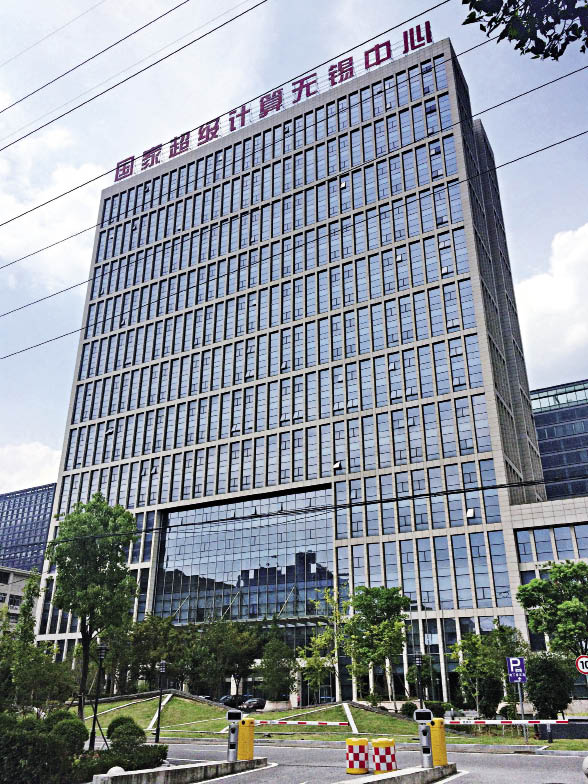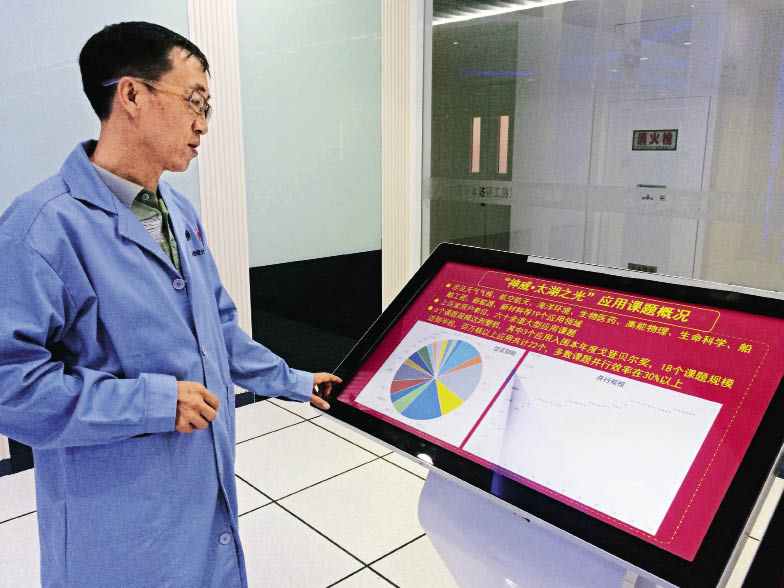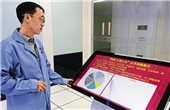Yang Guangwen: Builder of the Most Powerful Computer
China Today by Lu Rucai, October 13, 2016 Adjust font size:
National Strategy
Before Sunway was unveiled last June, visitors were prohibited from the National Supercomputing Center labs in Wuxi. The ban has now been lifted, but visitors must be accompanied by an authorized technician. Our reporter was instructed to wear the white coat bearing the Sunway logo and the name of the center – a reminder that we were approaching the world’s most powerful computing system.

The office building of the National Supercomputing Center in Wuxi.
Born in 1963, leading scientist Yang Guangwen started researching supercomputing as early as 1994. He was selected for the expert panel of the “863 Program” in 2002.
The “863 Program” is a special national program dedicated to improving China’s capacity for independent development of cutting-edge technology. Initiated in March 1986, it is referred to as “863.”
In 1983, three years before the program started, China developed Yinhe-1, the first supercomputer in the country capable of computing 100 million times per second. It marked China’s entry into the supercomputing club, but there was still a large gap between China and other leading countries.
The National University of Defense Technology developed Yinhe-1A in 2009. It ranked first on the TOP500 list with a theoretical peak performance of 4.701 petaFLOPS. Later, Tianhe-2 retained its top slot six consecutive times until Sunway took over.
“It took only two years to develop the Sunway TaihuLight,” said Yang Guang-wen, “because we had accumulated decades of experience in this field.” Sunway’s biggest plus is that it uses Chinese-designed chips, and the software and applications are developed and manufactured independently. “And our supercomputer consumes lower energy,” Yang added.
Sunway TaihuLight is the world’s first system with a peak performance greater than 100 petaFLOPS. It has a LINPACK benchmark rating of 93 petaFLOPS, three times that of Tianhe-2.
Sunway is also one of the most energy-efficient supercomputers, at 605.130 MFLOPS per watt. “Compared to the best systems in the U.S. and Japan, Sunway has achieved energy consumption three times as efficient,” said Fu Haohuan, associate professor at the Center for Earth Systems Science at Tsinghua University, and vice director of the National Supercomputing Center in Wuxi.
“The entire system is composed of 40,000 chips, with 260 cores on each chip,” Fu explained. He led the team which unveiled the Sunway TaihuLight system in Frankfurt in June. “That this giant system runs on such low energy is a great innovation.” Fu recalled how many experts from other countries were astounded.
In addition, the total amount invested in Sunway is only RMB 1.8 billion. “This is another jaw-dropping fact for foreign experts,” said Fu Haohuan.
“Building supercomputers was a national initiative,” said Yang Guangwen, “whether it made money or not.” Since the “863 Program” was launched, China has made developing high-performance computers a priority. “I think one reason is the desire to break the blockade from other countries.” Yang recalled how machines imported from the U.S. could only be used under American “guidance.” “It felt like a slap in the face,” he said.
In 2015, the Tianhe-2 development team was forced to change their original R&D path because of an embargo on Intel chips from the U.S. In contrast, all research and development for the Sunway TaihuLight (initiated at the same time as Tianhe-2) was done in China.
“The country is calling for innovation, especially in technology,” Yang said. “We developed a complete plan in the field of supercomputing, so were able to break through the U.S. technological barrier.”
On July 15, the Sunway TaihuLight was recorded in the Guinness Book of World Records as the World’s Fastest Computer. Rowan Simons, president of Guinness World Records, Greater China, presented the certificate to Yang Guangwen, calling it “a historic breakthrough for China in the field of supercomputing.”

Yang Guangwen explains the applications of the Sunway TaihuLight.
At present, the demand for supercomputing in China is enormous. The supercomputer Yang Guangwen is in charge of at Tsinghua University supports over 200 tech teams from 35 colleges and departments who have published more than 100 world-class theses. Yang believes the demand will be even greater in areas such as national security, aerospace, weather and climate, industrial manufacturing, and pharmaceuticals. This is one reason why China is sparing no effort in this field.

